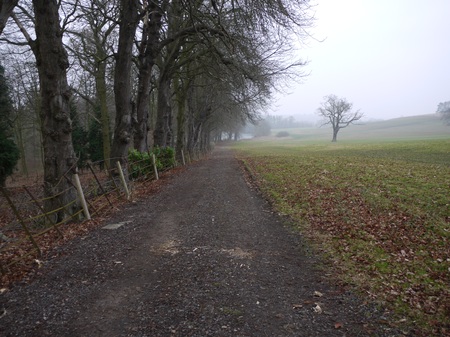Original URL: https://www.theregister.com/2009/01/30/review_micro_four_thirds_camera_panasonic_dmc_g1/
Panasonic Lumix DMC-G1 12Mp µ4/3s camera
The future of the bridge camera?
Posted in Personal Tech, 30th January 2009 13:02 GMT
Review You know the saying: if it looks like a duck, walks like a duck and quacks like a duck, then it must be a duck. Well, Panasonic’s DMC-G1 looks like a digital SLR, has interchangeable lenses like a DSLR – but it isn’t a DLSR. No sir, the G1 ushers in a new generation of cameras designed to blast a hole right through the middle of the so-called hybrid/bridge/superzoom market. So, is the G1 a wolf in sheep’s clothing, a sheep in wolf’s clothing or simply in a class of its own?
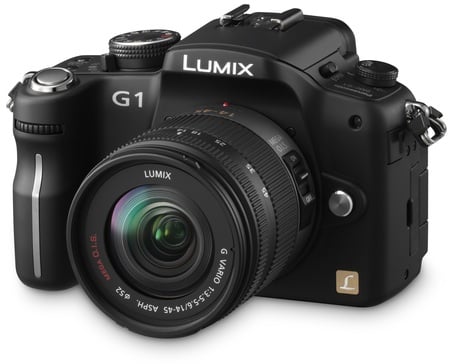
Panasonic's Lumix DMC-G1: wolf in sheep's clothing? Or vice versa?
The premise behind the 12Mp G1 goes something like this: if you were inventing a digital camera today, you wouldn’t base it on technology originally designed for a film camera. So why not start with a blank piece of paper, redefine the digital camera and take advantage of the advances in technology? It’s a compelling argument, but there’s also a lot to be said for sticking with tried and tested technology – that’s why computer manufacturers kept the typewriter's Qwerty keyboard.
The G1 is an evolution of the Four Thirds system developed by Kodak and Olympus. Its name is derived from the fact that it uses a 4/3-type image sensor, the effective imaging area measuring 17.3 x 13.0mm. This is smaller than the sensors used by DLSRs but much larger than those found in compacts.
The advantage of the 4/3 sensor is that the camera’s optics can be shrunk, so that a Four Thirds lens with a focal length of, say, 200mm is comparable with a 400mm lens on a 35mm camera.
Micro Four Thirds - developed by Panasonic and Olympus - takes this size reduction even further by dispensing with the traditional SLR mirror box and using an all-electronic viewing system.
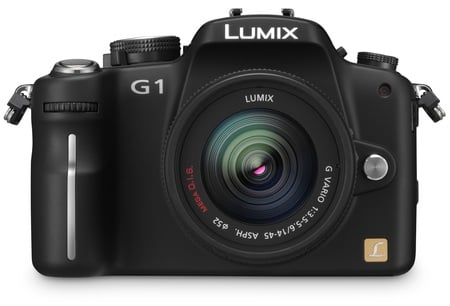
Not pocket friendly
Enough of the theory - let’s take a look at the G1. The first thing you notice is how much it looks like a regular DSLR, albeit one that has been shrunk a little in the wash. That said, if you’re expecting a Micro Four Thirds (MFT) camera to be the sort of product that James Bond secretly slips into a matchbox, think again, because the G1 isn't much smaller than some of the smallest DLSRs on the market. It measures 124 x 83.6 x 45.2mm and the body weighs 385g. The Olympus E-420 DSLR measures 129 x 91 x 53mm and is actually 5g lighter.
So the G1 is definitely not pocket-sized - even if your coat has deep pockets.
There’s a choice of three body colours: black, blue or red, although the latter looked more burgundy on our review sample. At present, there are only two MFT lenses: a Lumix G Vario 14-45mm/F3.5-5.6, equivalent to a 28-90mm on a 35mm camera, and a 45-200mm/F4.0-5.6 - 90-400mm in 35mm-speak. Our model came with the former. You can also use standard Four Thirds lenses but you lose the autofocus capability, as this is built into MFT lenses.
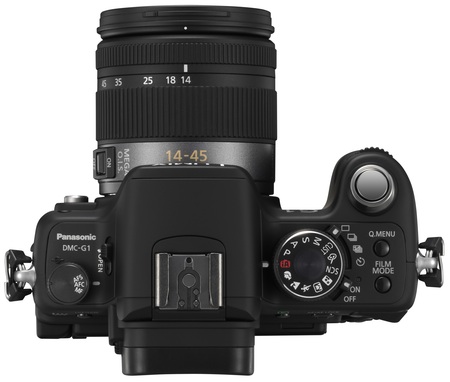
Comes with a Lumix G Vario 14-45mm/F3.5-5.6 lens
In order to encourage users to migrate to MFT, Panasonic has added a few touches to make the G1 seem more familiar. There’s the fake prism bump at the top of the camera body for a start, not to mention dangling metal lugs for the camera strap - and it even has a mechanical shutter. The latter means that, in action, the G1 is not much quieter than your average DSLR.
As you might well expect, then, there’s is a split personality feeling to this camera. You get Panasonic’s Intelligent Auto system, which does everything bar tell you what picture to take, but there’s also a manual mode and all points between the two. It uses a contrast AF system found on compacts rather than the phase-difference system used by DSLRs.
There’s a multi-zone AF system with 23 areas, plus a single area mode which allows the user to select the focus area. You also get Face Detection and AF Tracking systems. In short, the G1 aims to please a wide range of potential users.
A brief tour of the camera body reveals a flap covering mini USB and HDMI ports on the left, while on top, are a focus mode dial, flash release switch, large command dial, a lever for setting the drive mode, on/off lever, Quick Menu and Film buttons, shutter button and a control dial at the front which is used for selecting and setting parameters, such as the amount of exposure compensation. The dial can also be pushed in for selection purposes.
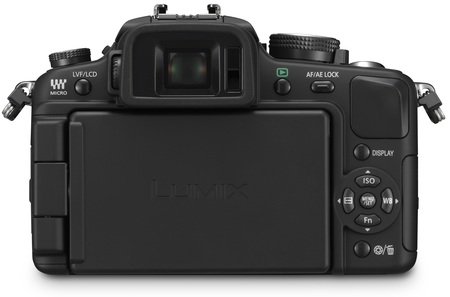
Fold the LCD away to keep it safe
On the back is a button for selecting the Live Viewfinder - Panasonic’s name for the electronic viewfinder - or LCD. The former uses LCOS technology and offers 1.4 million dot resolution with a 60f/s refresh rate, while the 3in LCD screen offers 460,000-dot resolution. Oddly, the LVF has a 4:3 aspect ratio, while the LCD screen’s is in 3:2. Moving on, we find the playback button, AE/AF lock, a plastic thumb rest, four way-controller for ISO, white balance, AF mode and function select and a delete button. On the right is a flap for the SD/SDHC/MMC card and, underneath, the lithium-ion battery compartment.
Sample Shots
Examples of the sort of quality you can get from the DMC-G1.
Sample Shots


One disappointment is the camera’s colour reproduction, which is a little insipid.
Click ISO images for full-resolution crops
We feared that the G1’s smaller image sensor - when compared with a DSLR's - would mean more noise, but in fact, noise doesn’t become an issue until around ISO 800.
Sample Shots
An example of the macro mode.


The G1 kit includes a Lumix G Vario 14-45mm/F3.5-5.6, which is equivalent to a 28-90mm on a 35mm camera. These shots show you what you get at the extreme ends: telephoto (top) and wide.
A quick rundown on features shows the G1 includes: JPEG and Raw file formats with a top resolution of 4000 x 3000 pixels; an ISO range of 100-3200; a shutter speed range of 60-1/4000s with Bulb - up to four minutes - and top burst speed of 3f/s; and various scene modes - portrait, night etc. There are lots of Film modes, such as nature, and black and white, which can be adjusted for contrast, saturation and other parameters.
Panasonic supplies PhotofunStudio photo management software and SilkyPix software for processing Raw files. One thing you don’t get is a movie mode, which is odd, for a camera sporting an HDMI port.
The G1’s body has a rubberized coating that makes it nice to handle. However, we found it a bit cramped to use, especially when adjusting the lens. Although it’s not pocketable, the G1 is easy to carry around in one hand. A few things we weren’t so keen on were the front control dial, which is easy to press accidentally and so alter the exposure compensation setting. It’s also easy to inadvertently hit the power lever. When you remove the lens, the lack of a mirror means that image sensor is exposed to the elements, so don’t hang about during this process
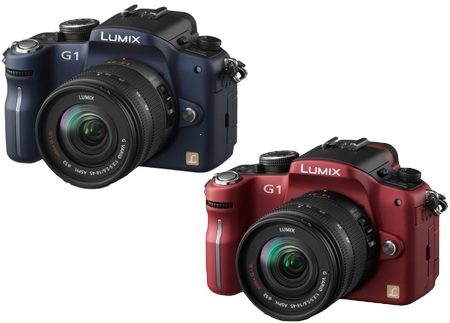
Also available in blue and red
On a happier note, the LVF is superb – it’s sharp, clean and clear, with only a little blurring when fast panning, and the some flicker when shooting indoors under artificial light. The LCD screen flips out and twists, and is great for shooting at various angles. If you put your eye up to the LVF, a sensor ensures that the LCD automatically switches off.
Switch on was very fast – around half a second, and shutter lag wasn’t a problem. A depth of field preview mode is provided, and you can even preview the effect of changing the shutter speed – nice one, Panasonic.
In terms of performance, the G1 did pretty well. With the camera using a smaller sensor than a DSLR, we expected noise to be a problem, but this wasn’t noticeable until around ISO 800. We also expected the all-electronic viewing system to drain battery power fast, but we took several hundred shots and there was still plenty of power left. We also expected the contrast AF system to struggle, but it was fast and responsive. Resolution was good too.
So the DMC-G1 performed beyond our expectations. Well, almost. One disappointment was that colour reproduction, which was a little insipid. But overall, we were happy with the DMC-G1’s efforts.
Verdict
Does the DMC-G1 mark the beginning of a new era for digital photography, or is it heading down a technological blind alley like the now forgotten Advanced Photo System? There's a lot to like about the G1, but it has the feeling of a product still undergoing development. It’s as if Panasonic is still trying to find the right mix of ingredients that will appeal to someone who wants to move from a compact to something more advanced, and, at the same time, make the G1 appear both fresh and familiar. If you like being a technology pioneer, you might be tempted to take the plunge - otherwise you may prefer to wait to see what Panasonic does with the next version. ®
More Camera Reviews...

Nikon D90 |

Fujifilm S100 FS |

Pentax K200D |

Olympus SP-570 UZ |


